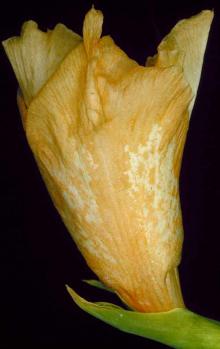See:
Cause Cucumber mosaic virus (CMV), subgroup I, spread by aphids. The source of CMV infection is previously infected gladiolus, in which corms maintain the virus during dormancy and then produce infected leaves each season upon which aphids feed. CMV, however, can infect over 1,200 plant species including important agronomic crops. The mode of aphid transmission is nonpersistent or stylet-borne. Although the virus is mechanically transmitted in many other crop systems it is not generally transmitted this way in gladiolus. Mixed infections with Bean yellow mosaic virus produce more severe symptoms.
Symptoms Cultivars differ in symptom expression but are generally symptomless until flowering. The most striking symptoms are in flowers but may not be apparent at cutting time. Most common is color breaking (spotting or streaking) on florets. The degree of breaking depends on the cultivar affected. Spots or streaks, |always lighter than normal color, are usually white, grayish, light green, or yellow-green. Florets may change color, sometimes accompanied by reduced size, thickened petals, and twisted and deformed florets. Also, hue may change from normal to lighter. Gray or yellowish green streaking or flecking can occur on leaves. On some cultivars, the gray or yellowish green spots are small and numerous. Stunting of the plants is often associated with severely affected leaves. Sometimes diseased plants produce warty or deformed corms.
Cultural control
- Use new seedling cultivars that have been tested and found to be free of all known viruses.
- Plant pathogen-free corms.
- Rogue affected plants thoroughly and persistently.
- Control aphids. See PNW Insect Management Handbook for details.
- Grow plants under fine mesh nets.
Reference Aebig, J.A., Kamo, K., and Hsu, H. 2005. Biolistic inoculation of gladiolus with cucumber mosaic cucumovirus. Journal of Virological Methods. 123: 89-94.



